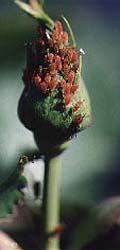
As an professional entomologist, I often get asked to recommend biological and non-chemical control measures to control bugs on the roses and in the home landscape. My answer can vary depending on the person and the level of control that is wanted. In biological control we believe in living or tolerating a certain level of the pest. Biological control is definitely not eradication of the pest! The basis of biological control is that some of the pest organisms will remain to keep beneficial insects alive and in the garden. Biological control is the deliberate use of the pests natural enemies in order to bring the pest under some level of control -- hopefully one that we can tolerate. The natural enemies can consist of the predators (lady bugs), parasites (parasitic wasps), and diseases (viruses, bacteria, fungi, etc.).
In this article I would like to discuss biological control and non-chemical methods of pest management that can be used in the rose garden. If you would like to get a copy of "Suppliers of Beneficial Organisms in North America", please send a written request to: Charles Hunter, Environmental Monitoring and Pest Management Branch, California Department of Pesticide Regulation, California Environmental Protection Agency, 1020 N Street Room 161, Sacramento, CA 95814-5604.
Organic gardeners accept a narrow list of pesticides. Among these pesticides are the botanical pesticides such as natural pyrethrum, rotenone, sabadilla, etc. which can be used as contact pesticides to control most of the insects discussed in this list of pests. Other pesticides accepted in organic gardening include insecticidal soaps and oils, and microbial insecticides. An example of an insecticidal soap is Safer's Insecticidal Soap. This product can be used for the control of aphids, thrips, scale insects, and spider mites. Repeated applications are a must as recommended on the label. The microbial insecticide "BT" (Bacillus thuringiensis), found in products such as Dipel and Attack, contain bacterial spores of Bacillus thuringiensis which contain delta-endotoxin crystals, a very specific stomach poison for caterpillars. AVID, a new miticide-insecticide, is derived from a soil-borne fungus. It is very effective against spider mites and thrips.

These insects are the first ones that show up in my rose garden. In severe winter areas the aphids overwinter in the egg stage but mild winter areas the aphids may overwinter in all life stages, especially in protected plants near homes. Aphids excrete a sweet substance call "honeydew" which often times attract large numbers of ants. The ants can be very disruptive in biological control programs. Natural enemies of aphids include a number of parasitic wasps, lady beetles, lacewings, flower fly larvae, a predaceous midge, and others. If these natural enemies are protected or better yet, augmented through biological control releases, they in time may bring aphid populations under control. Commercial biological control agents include green lacewings, a predaceous midge, and convergent lady beetles.
Aphids can also be dislodged from rose foliage and rose shoots with a forceful spray of water directed toward the underside of the foliage and toward succulent rose growth. Water applications must be made at least twice per week in order to be effective in keeping the aphids off the plants.
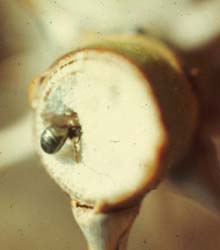
"Cane borers" should be considered a beneficial insects equal in rank to the lady beetles and the green lacewings. Their damage is mainly cosmetic as they only bores into the pith of rose canes. I have seen many lateral canes growing from canes containing pith nesting wasps without showing any signs of weakness. If you see these "cane borers" or signs of their nests in your garden, consider yourself lucky for having such a hard working beneficial insect around. On the other hand, if their nests really bother you, why not seal the cut canes with sealants such as Elmer's Glue, Tree Doc, or orange shellac?
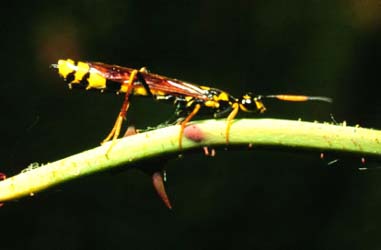
This insect is not really a horntail wasp but actually a primitive wasp in the stem sawfly family. No natural controls or realistic non-chemical control methods are presently known for controlling the adult stem sawflies before they lay their eggs on succulent rose growth. This pest is probably the most challenging to organic rose growers. Fortunately they are only active from late March through early June.
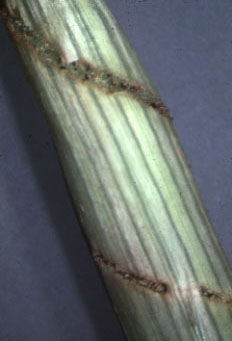
Some level of control can be achieved by pruning off the infested canes as soon as damage is recognized. Also, avoid planting host plants such as raspberries and boysenberries.
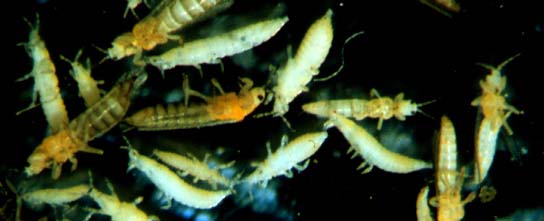
Control of thrips is very difficult due to the high level of control that most rosarians would like. This is further complicated by the inability by most rosarians to distinguish thrips from beneficial predators (e.g., predaceous thrips, mites, pirate bugs, etc., etc.). In my own rose garden, I am very tolerant of thrips damage, and I rely on their natural enemies (e.g., predaceous thrips (black hunter thrips), some species of lady beetles, pirate bugs, etc.) for control. I recently saw an article on biological control which listed at least two different species of commercially available natural enemies.
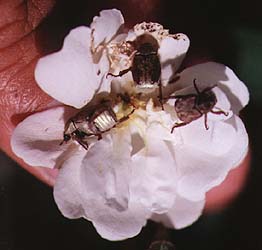
Hoplia beetles belong to the scarab beetle family and are relatives of the Japanese beetle, Chinese rose beetle, Asiatic garden beetle, European rose chafer, and rose chafer, all of which are not found in California. Hoplia beetles are native insects which are active from mid-April through June. The control measure I use in my garden is strictly hand picking the beetles from the blooms and dropping them into a jar with alcohol.
A few years ago Dr. Kirby Brown, former entomologist with the San Joaquin County Department of Agriculture in Stockton, California, told me about a non-chemical control measure which he has found very effective for Hoplia beetles. The control measure involves the placement of white, 5-gallon buckets filled with water throughout the rose garden. Kirby adds some detergent added to break the surface tension and as the beetles are attracted to the white buckets they fall in the water and drown.
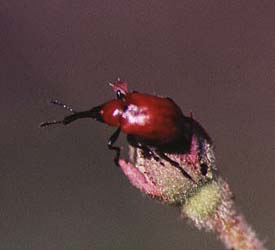
Rose weevils are reddish and black in color and have a characteristic snout on their heads. The chewing mouthparts are found at the tip of the snout. The adult weevils appear throughout California from April through June. In my rose garden I find that the small pirate bugs are great natural enemies against these weevils. These pirate bugs are about 1/16" long, and they are usually found within the unfolding petals, searching for weevil eggs and larvae.
Since rose weevils develop in buds (feeding on flower petals and seeds), populations of the weevils in the home can be diminished substantially by pinching off damaged buds or spent bloom soon after petal fall. Do not let damaged buds fall to the ground as the weevil larvae will emerge from these buds and burrow into the adjacent soil where they will overwinter and emerge from the following spring.
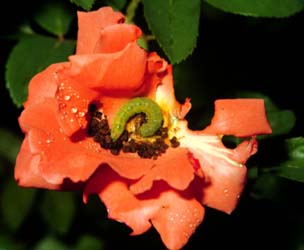
The microbial insecticides, Dipel or Attack, will control both fruit tree leafrollers and tobacco budworms, our two main pests in the area. These microbial insecticides contain bacterial spores of Bacillus thuringiensis which contain delta-endotoxin crystals, a very specific stomach poison for caterpillars. In my garden, I have achieved excellent control of both pests with Kryocide, an inorganic insecticide. Preventative insecticidal treatments are a must in order to prevent severe defoliation by these two pests. Leafrollers can be further controlled by the use of insecticidal oils contained in insect dormant sprays. To be effective, the oil sprays should be directed at the overwintering egg masses on trees and shrubs during the dormant season.
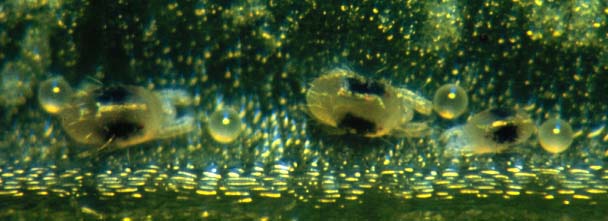
The most common species is the two-spotted spider mite. Effective biological control agents against spider mites are available commercially which can be introduced into the rose garden early in the season before populations have a chance to build up. Some of the available biological controls are even resistant to Carbamate and/or Organophosphate insecticides.
Just like aphids, spider mites can also be effectively controlled by washing the undersides of leaves with water at least two times per week. To do this, use a water wand with a misting head and direct the jet of water to the underside of the leaves.
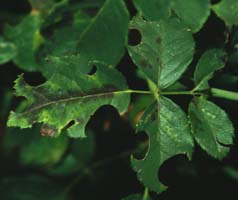
Adult bees are usually active from May through September (depending on the area). The main damage by these bees is to the foliage. They cut smooth, circular or crescent- shaped pieces from the leaf edges, and take them back to their nests. The bees use previously burrowed holes (e. g., nail holes, abandoned insect nests, etc.) to construct their nests. Within the nests, leaf-cutter bees use the leaf pieces line the walls and construct brood cells for their offspring. No pesticides controls are registered for leaf-cutter bees.
![]()
If you have any questions or constructive comments, I would love to hear from you, please send e-mail to Baldo Villegas
[ Home ]
[ Rose Pests Master List]
[ Rose Diseases ]
[ Insect, Mites, and other Animal Pests ]
[ Abiotic Rose Problems ]
[ Weed Pests ]
[ Hawaii Pests ]
[ The Good Guys ]
[ Help! Rose IPM ]
[ Horticulure Links ]
Copyright© 1995-2002 by Baldo Villegas
Last updated: January 21, 2002